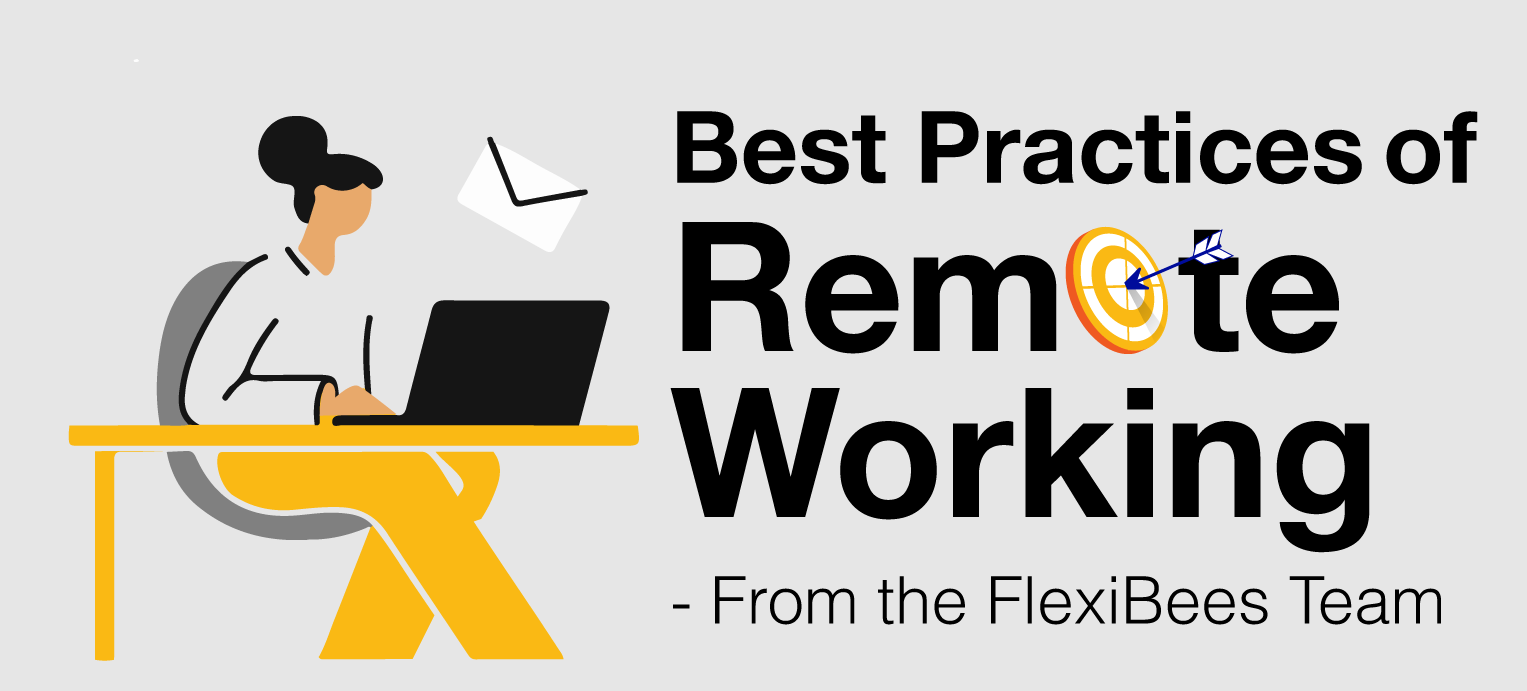Best Practices of Remote Working - From the FlexiBees Team
Getting people to collaborate, not just within their own teams but with cross-functional teams as well, is the single most important challenge that many organizations face. This, with the twist of the ‘new normal,’ amid this raging pandemic is a whole other ball game. Many organizations and employees who have never worked remotely before are now suddenly in the midst of it and grappling with its nuances. But, this model is here to stay as organizations are choosing to make remote working a permanent feature even beyond the pandemic.
There are many advantages to successfully building and managing a remote team - it is cost-effective, reduces overheads, and removes geographical barriers to create teams that truly complement each other in terms of skills and strengths.
Even though FlexiBees has been a completely remote and flexible organisation from its inception, it was not without challenges. There was a definite and distinctive learning curve before we all learned to work smoothly like a well-oiled machine.
Today, we present some of our challenges, our teething problems, and our unique solutions that have worked for us.
#1. Operational roles come with their time urgency demands
# Challenge: Our Operations - Project Manager, Arpita, is the one who is most in touch with all cross-functional teams - Finance, HR, BD, marketing, digital & our talent pool. During the normal course of events, she has to coordinate across many of these teams - not an easy job by any means. And when the occasional incident occurs, she finds herself racing against tight deadlines.
How does she do it in a remote environment?
There are some parts of her job that are predictable, so she plans for those. It helps deal with the unpredictable ones when they arrive with “urgent!” written all over them. She also thinks through the communication well and ensures all relevant stakeholders are in the loop and have the right information to make quick decisions.
In her own words, ‘ I plan days and weeks ahead of schedule and create efficient to-do lists & notes. Assign and track the status of tasks, renewals, consultant placements, and client requirements to ensure smooth fulfillment and transitions.’ She ends with a sentiment that would hold good across all workplaces, remote or not, ‘ I try and maintain transparency, build trust and relationships with all stakeholders.’
#2. Business Development roles have the unique challenge of building relationships in the ether or over a telephone line
# Challenge: In the remote working set up there are no meetings that are conducted in-person barring video calls. However, it is important to build a rapport to crack the deal in the first place and then get repeats. So how does one go about doing that?
How does Sonal build client relationships in a remote environment?
‘Building your relationships virtually can be challenging. You need to work a little harder but it does happen over a period of time.’, says Sonal, one of our most experienced BD managers.
Her secret sauce has been to be available and prompt, which has helped her build trust and develop relationships with her clients. This serves a purpose beyond just getting the job done, it tells the client that she is dependable. She is the go-to for many of her clients when they are in a bind and need to hire someone urgently; it’s a reputation she has earned over the years with hard work and determination. While the need for dependability is there even in brick and mortar businesses, in a virtual set up, it becomes even more important and can quickly become a strong differentiator.
Additionally, she invests some time to chat up informally with her clients and getting to know them better. For example, she always logs in a few minutes earlier than scheduled to have a few minutes with the client. ‘ At that point, it is not about the negotiation - I ask questions about them and their business. Sometimes, when the business conversation is done with, I make it a point to have a short chat with the client, if I have not had the time before the interview began.’
#3. Finance roles have heavy coordination and a need for data precision
# Challenge: Operational Finance roles are usually very data-heavy, with a lot of coordination needed with cross-functional teams. Say, to enable contracting or billing, information needs to flow in from multiple centers, including Recruitment, BD, Ops, etc, and then needs to be sent out to multiple ones as well. Everything needs to be first-time-right along with being on-time.
How does Aboli manage this ON-TIME-IN-FULL delivery entirely from her desk?
‘Trackers! I create trackers that each team can fill in with relevant updates and timely information. Make this a consistent process that the team needs to repeat every single time and so they get the hang of it.’, says, Aboli, Finance Manager.
She has also made messaging groups to streamline communication. ‘ To ensure quick communication and query responses, the finance team has different instant messaging groups - like Finance Founders, Finance CA, Finance Legal & Operations, etc.’, she says.
Not only is Aboli overcoming the challenge of a remote environment, but she is also playing it to its strengths by using asynchronous trackers and virtual messaging channels that drive clarity, and reduce the need for additional phone calls or meetings for information or clarification. In the case of the trackers, each stakeholder works on it during their available time. Now after having done this process multiple times, there is an easy rhythm, and of course, the rapport they all share helps as well.
#4. Recruitment has the tough task of managing expectations of both internal and external stakeholders
# Challenge: The recruitment team needs constant interaction with the BD team to understand the roles they are fulfilling for them, as well as to update on progress. On the other hand, they communicate with hundreds of consultants every week.
It’s time-sensitive and high-stake.
How does Shipra, who heads recruitment, manage the workload and expectations, all remotely?
Through sheer hard work, and by setting the right expectations and priorities for her team too. Nothing beats good old communication and ensuring everyone has the information they need for doing their jobs. Remote or no remote, it’s the only way to get the job done.
"I schedule regular calls with the BD managers to get an update and give them an update too. We also share candidate progress with the candidates regularly. Additionally, I have a morning meeting with everyone from my team for a daily status update and to sort out issues. I am also available for constant interaction during the day. Communication is key’’, she says.
She also mentions that they are in the process of developing a tracker between the teams. Then everyone can update it and need not call every time they need information or an update.
#5. Marketing teams, usually comprising people with different skills, have to come together and CREATE on a daily basis
# Challenge: The Marketing team comprising Content, Design, and Digital, has to work in close tandem with each other. They need to conceptualise, develop, design, publish, track, and analyse every piece of creative across multiple social media channels.
Content drives the process by being the ones who own the content calendar and the people who conceptualise each activity. The biggest challenge is to coordinate between the teams to get everything done in time. It’s like a relay race that sometimes runs backward as well since they also have to factor in time for rounds of feedback and revisions, if and when required. And sometimes it comes down to the wire!
How does Deepthi, who leads Content Marketing, do it?
She works ahead of time to factor in time for revisions and gives enough time for the Graphic team to come up with creative ideas.
‘I create monthly calendars and share them with the Graphic and Digital Marketing teams. I also send out weekly task sheets with assigned responsibilities every Monday to ensure smooth deliveries for the week.’, she says. Most importantly, she plans for contingencies, ‘ It helps to have back-up options or contingency plans to quickly post something on days when we haven’t been able to publish the intended posts.’
How can YOU do it for your teams?
- Define clear processes and workflows.
- Set clear expectations, especially in terms of timelines.
- Spend time in planning and create calendars and task lists that can be assigned to each team member.
- Create tracking systems and provide access to all stakeholders so everyone can update it and have access to information.
- Pick communication channels that allow for quick responses and reduced delay.
DIfferent functional teams have different challenges and have evolved their own solutions that work for them. It is important to let the people who are at the ground level decide how they want to handle a particular situation rather than mandating the same solutions to everyone.
Above and beyond this, have a strong leadership team that truly enables and empowers the teams to build a culture of accountability and ownership. The leadership team at FlexiBees is hands-on and ready for a chat or to give guidance when needed and let go and let the team take the lead when they are ready. They set the teams up for success by giving them space to work, grow, and truly shine.
Are you currently running a flexible team? What steps have you taken to ensure its success?

